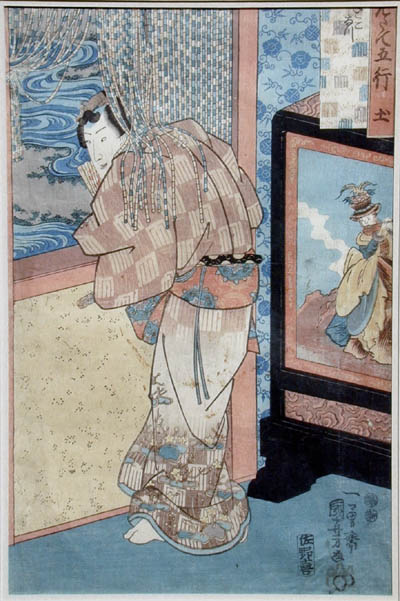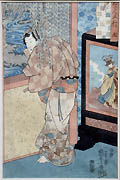| Title: |
Earth: Tsuchi (Prince Genji Looking at The Garden Through His Window) |
| Artist: |
Kuniyoshi, Ichiyasai (Japan, 1798 - 1861) |
| Date: |
c. 1850 |
| Medium: |
Original Japanese Woodcut |
| Publisher: |
Sano-ya Kihei (Sanoya Kihei) |
| Source: |
Mitate go gyo (The Selected Five Elements) |
| Note: |
"Kuniyoshi was a master of many facets but in the fields of
legend and history he reigns supreme. His is the work that forms the
yardstick against which all others are judged." *
|
| |
Mid nineteenth century Ukiyo-e art is best represented in
its three most illustrious artists. The woodcuts of Hokusai and Hiroshige
are permanently linked to the greatest images in Japanese landscape art.
Yet the third master artist, Ichiyasai Kuniyoshi, was equally adept at landscape,
satire and in his famous legend and warrior prints, of which this is a classic
example. |
| |
A student of Toyokuni, Kuniyoshi in his art has always seemed
more akin to Western thought and style than any other Golden Age Japanese
master. He was, after all, the first to attempt consolidating Western temperament
and themes into his art, usually with remarkable success. |
| |
Ichiyasai Kuniyoshi's finest art was created from the 1830's and into the later years of the 1850's. After that date continuing ill health left its mark. His most famous works draw from legend and history which gave him the imaginative vehicle to portray a vast spectrum of human emotions. His influence on the course of the Japanese woodcut was enormous and was directly passed on in the Meiji era to his best student, Yoshitoshi. |
| |
This original Kuniyoshi woodcut, "Earth (tsuchi)" depicts Prince Genji looking at the garden through his window. An important feature of this work is the panel of art seen on the right hand margin. This is an early representation of Western art in the Japanese woodcut. Prince Genji is one of the greatest heroes of Japanese legend and folklore. "Earth (tsuchi)" was published by Sanoya Kihei (Sano-ya Kihei), in 1850 for Kuniyoshi's famous series, Mitate go gyo (The Selected Five Elements). The series deals with the "Shining Prince Genji" (Hikaru Genji), and his amorous exploits, a subject that relates to the Tales of Genji a novel, composed by the Lady-in waiting, Murasaki Shikibu, and the famous updated adaptation, Nise murasaki inaka genji (False Murasaki and a Rural Genji), written by Ryutei Tanehiko. |
| |
The novel, Nise murasaki inaka genji (False Murasaki and a Rural Genji), written by Ryutei Tanehiko (1783-1842), became Japan’s most popular illustrated book of the early nineteenth century. The Nise murasaki inaka genji (False Murasaki and a Rural Genji) was an updated adaptation of the 11th century classic tale of Prince Genji, liberally borrowing scenes from contemporary novels and the kabuki theatre. To say that the novel was popular might be an understatement. Between 1829 and 1842 Ryutei Tanehiko published thirty-eight chapters or installments of Genji, each illustrated by Kunisada and his pupils. And, after the last chapter was published, the craze for scenes from Genji continued well into the century with the creation of further books by different authors and many more woodcuts on the Genji theme by not only Kunisada, but by such other great masters as Kuniyoshi, Yoshitoshi, Kunisada II, and other important Japanese artists. Such is the case with this original Ichiyasai Kuniyoshi woodcut, Earth: Tsuchi (Prince Genji Looking at The Garden Through His Window) from his famous series, Mitate go gyo (The Selected Five Elements) which deals with Prince Genji's amorous exploits. Ryutei Tanehiko's, Nise murasaki inaka genji follows the exploits of the handsome warrior, Ashikaga Mitsuuji (second son of the 8th Ashikaga Shogun, Yoshimasa), a character based upon the "Shining Prince Genji" (Hikaru Genji, son of the emperor by a favored lady). Unlike the eleventh century setting portraying Japanese court culture of the Heian period (794 - 1185), described in the Tale of Genji, a novel, composed by the Lady-in waiting, Murasaki Shikibu (c. 973 - c. 1014 / 1025), Tanehiko's, Nise murasaki inaka genji takes place during the fifteenth century Ashikaga Shogunate, a feudal samurai government ruled by the shoguns of the Ashikaga family (1336-1573). Unfortunately, although the setting was based in the Ashikaga Shogunate, it was believed the Inaka Genji reflected much of the current Shogun, Tokugawa Ienari, and his court. Consequently, in 1842, during the Tenpo Reforms, the woodblocks for the Inaka Genji were confiscated and Tanehiko was told to seize publication. Soon after (1842), Ryutei Tanehiko died, leaving the last two chapters of his book unpublished. |
| Reference: |
* Richard Illing, The Art of Japanese Prints, Gallery
Books, New York, 1983, pp. 120-122. |
| Size: |
Oban (Sizes in inches are approximate, height preceding
width of plate-mark or image.) |
| |
Framed and Matted with 100% Archival Materials |
| Condition: |
Ichiyasai Kuniyoshi's Earth Tsuchi Prince Genji Looking at The Garden Through His Window has been printed on mid-nineteenth century mulberry (rice) paper and with full margins as published by Sanoya Kihei in 1850 for Kuniyoshi's famous series, Mitate go gyo (The Selected Five Elements). Note: An important feature of this work is the panel of art seen on the right hand margin. This is an early representation of Western art in the Japanese woodcut. Prince Genji is on of the greatest heroes of Japanese legend and folklore. One very faint stain exists in the centre of the image, else a finely printed impression. |
| Price: |
Sold - The price is no longer available. |
| Important Information: |
The artist biographies, research and or information pertaining to all the original works of art posted on our pages has been written and designed by Greg & Connie Peters exclusively for our site, (www.artoftheprint.com). Please visit us regularly to view the latest artworks offered for sale. We will soon be posting an update of our most recent research and include the biographical and historical information pertaining to our next collection of original works of art created by artists throughout the centuries. We hope you found the information you were looking for and that it has been beneficial.
Our Gallery, (Art of the Print / www.artoftheprint.com) guarantees the authenticity of every work of art we sell 100%. Full documentation and certification is provided. We offer a wide selection of international fine art dating from the early Renaissance to the contemporary art period. |




![]()
![]() or
phone Greg & Connie (905) 957-6666
or
phone Greg & Connie (905) 957-6666